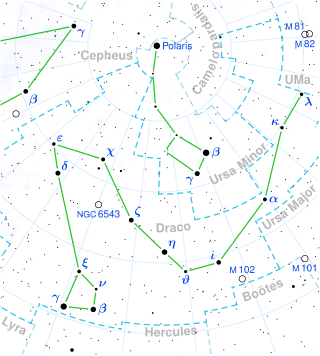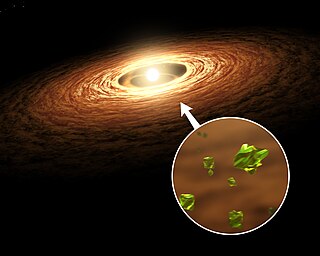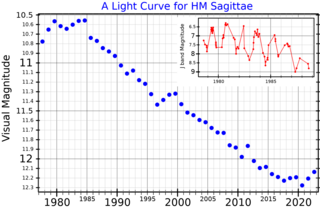
Beta Draconis, a name Latinized from β Draconis, is a binary star system and the third-brightest star in the northern circumpolar constellation of Draco. The two components are designated Beta Draconis A and B respectively. With a combined apparent visual magnitude of 2.79, it is bright enough to be easily seen with the naked eye. Based upon parallax measurements from the Hipparcos astrometry satellite, it lies at a distance of about 380 light-years from the Sun. The system is drifting closer with a radial velocity of −21 km/s.

T Coronae Borealis, nicknamed the Blaze star, is a recurrent nova in the constellation Corona Borealis. It was first discovered in outburst in 1866 by John Birmingham, although it had been observed earlier as a 10th magnitude star. It may have been observed in 1217 and in 1787 as well. It is expected to undergo an outburst again in 2024.

Kappa Draconis, Latinized from κ Draconis, is a blue giant star located in the northern circumpolar constellation of Draco. At an apparent magnitude of 3.88, it is barely visible to the naked eye when artificial lighting from cities is present. Nevertheless, it is a powerful star, approximately five time as massive as the Sun. It is about 460 light-years away, and is 1,400 times brighter than the Sun.

Mu Centauri, Latinized from μ Centauri, is a third-magnitude star in the southern constellation of Centaurus. With the stars ν and φ Centauri, it marks what has been traditionally portrayed as "dextro Latere" of the Centaur. The apparent visual magnitude of this star is 3.42, making it one of the brighter members of the constellation. The distance to this star can be estimated directly using parallax measurements, which yield a value of roughly 510 light years (155 parsecs) from Earth.
Z Andromedae is a binary star system consisting of a red giant and a white dwarf. It is the prototype of a type of cataclysmic variable star known as symbiotic variable stars or simply Z Andromedae variables. The brightness of those stars vary over time, showing a quiescent, more stable phase and then an active one with a more pronounced variability and stronger brightening and/or dimming.

EQ Virginis is a single variable star in the equatorial constellation of Virgo. It has a baseline visual apparent magnitude of 9.36, but is a flare star that undergoes sporadic bursts of brightening. The star is located at a distance of 67 light-years from the Sun based on parallax measurements, but is drifting closer with a radial velocity of −23 km/s. It is a member of the IC 2391 moving group of stars, which is between 30 and 50 million years old.

BK Camelopardalis is a variable star in the northern circumpolar constellation of Camelopardalis, near the constellation border with Cassiopeia. It is visible to the naked eye as a faint, blue-white hued star with an apparent visual magnitude that fluctuates around 4.74. The star is located approximately 540 light years away from the Sun based on parallax. It is a proposed member of the Cassiopeia–Taurus group of co-moving stars.

10 Draconis is a single star in the northern circumpolar constellation of Draco. It was a latter designation of 87 Ursae Majoris, and is visible to the naked eye with an apparent visual magnitude of about 4.6. The distance to this star, as determined from its annual parallax shift of 8.2 mas, is around 400 light years. It is moving closer with a heliocentric radial velocity of −12 km/s, and is expected to come to within 84 ly in about 8.6 million years.

CL Draconis is a single star in the northern circumpolar constellation of Draco. It can be viewed with the naked eye, having an apparent visual magnitude of 4.96. The distance to this star, as determined from its annual parallax shift of 29.9 mas, is 109 light years. It is moving closer to the Earth with a heliocentric radial velocity of −11 km/s. The star has a relatively high proper motion, traversing the celestial sphere at the rate of 0.185″/yr.

AG Pegasi is a symbiotic binary star in the constellation Pegasus. It is a close binary composed of a red giant and white dwarf, estimated to be around 2.5 and 0.6 times the mass of the Sun respectively. It is classified as a symbiotic nova; it has undergone one extremely slow nova outburst and a smaller outburst.

HN Pegasi is the variable star designation for a young, Sun-like star in the northern constellation of Pegasus. It has an apparent visual magnitude of 5.9, which, according to the Bortle scale, indicates that it is visible to the naked eye from suburban skies. Parallax measurements put the star at a distance of around 59 light years from the Sun, but it is drifting closer with a radial velocity of −16.7 km/s.

8 Draconis, formally named Taiyi, is a single star in the northern circumpolar constellation of Draco. Based upon an annual parallax shift of 34.14 mas as seen from the Earth, the star is located approximately 96 light-years from the Sun. It is moving further away with a heliocentric radial velocity of +9 km/s, having come within 40.6 ly some 2.6 million years ago.

EX Lupi is a young, single T-Tauri star in the southern constellation of Lupus. An irregular variable, it is the prototype of young, low-mass eruptive stars named EXors, with EX Lupi being this object's variable star designation. At its minimal activity level, EX Lupi resembles a classical T-Tauri star of the M0 dwarf type. The low latitude of this star, at a declination of −40°, makes it difficult for northern observers to view. Based on parallax measurements, it is located at a distance of about 505 light years from the Sun. The star lies next to a gap in the Lupus cloud complex, a star forming region.

HM Sagittae is a dusty-type symbiotic nova in the northern constellation of Sagitta. It was discovered by O. D. Dokuchaeva and colleagues in 1975 when it increased in brightness by six magnitudes. The object displays an emission line spectrum similar to a planetary nebula and was detected in the radio band in 1977. Unlike a classical nova, the optical brightness of this system did not rapidly decrease with time, although it showed some variation. It displays activity in every band of the electromagnetic spectrum from X-ray to radio.

V1005 Orionis is a young flare star in the equatorial constellation of Orion. It has the identifier GJ 182 in the Gliese–Jahreiß catalogue; V1005 Ori is its variable star designation. This star is too faint to be visible to the naked eye, having a mean apparent visual magnitude of 10.1. It is located at a distance of 79.6 light years from the Sun and is drifting further away with a radial velocity of 19.2 km/s. The star is a possible member of the IC 2391 supercluster.

LQ Hydrae is a single variable star in the equatorial constellation of Hydra. It is sometimes identified as Gl 355 from the Gliese Catalogue; LQ Hydrae is the variable star designation, which is abbreviated LQ Hya. The brightness of the star ranges from an apparent visual magnitude of 7.79 down to 7.86, which is too faint to be readily visible to the naked eye. Based on parallax measurements, this star is located at a distance of 59.6 light years from the Sun. It is drifting further away with a radial velocity of 7.6 km/s.

PU Vulpeculae is a very slowly evolving symbiotic nova in the northern constellation of Vulpecula, abbreviated PU Vul. It is too faint to be visible to the naked eye, reaching a maximum apparent visual magnitude of 8.7 following a minimum of 16.6. The system is located at a distance of approximately 17,000 light years from the Sun based on parallax measurements.

CX Draconis is an interacting binary star system in the northern constellation of Draco, abbreviated CX Dra. It has the designation HD 174237 in the Henry Draper Catalogue; CX Draconis is the variable star designation. This is a double-lined spectroscopic binary system with a near circular orbit. The brightness of the system undergoes long-term irregular fluctuations, ranging from an apparent visual magnitude of 5.68 down to 5.99. Based on parallax measurements, it is located at a distance of approximately 1,150 light years from the Sun.

4 Draconis, also known as HR 4765 and CQ Draconis, is a star about 570 light years from the Earth, in the constellation Draco. It is a 5th magnitude star, so it will be faintly visible to the naked eye of an observer far from city lights. It is a variable star, whose brightness varies slightly from 4.90 to 5.12 over a period of 4.66 years.

YY Draconis and DO Draconis are separate identifiers for what is likely the same cataclysmic variable system in the northern constellation of Draco, abbreviated YY Dra and DO Dra, respectively. The DO Dra binary star system is classified as a U Geminorum variable that ranges in luminosity from an apparent visual magnitude of 10.0 down to 15.1. It is located at a distance of approximately 639 light years from the Sun.



















